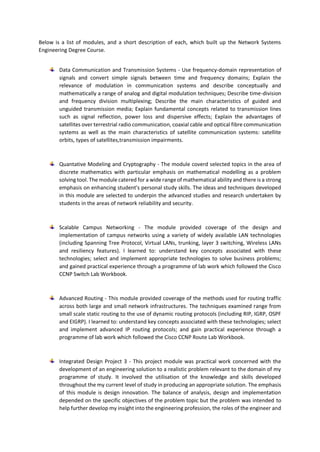
GCU list of modules
- 1. Below is a list of modules, and a short description of each, which built up the Network Systems Engineering Degree Course. Data Communication and Transmission Systems - Use frequency-domain representation of signals and convert simple signals between time and frequency domains; Explain the relevance of modulation in communication systems and describe conceptually and mathematically a range of analog and digital modulation techniques; Describe time-division and frequency division multiplexing; Describe the main characteristics of guided and unguided transmission media; Explain fundamental concepts related to transmission lines such as signal reflection, power loss and dispersive effects; Explain the advantages of satellites over terrestrial radio communication, coaxial cable and optical fibre communication systems as well as the main characteristics of satellite communication systems: satellite orbits, types of satellites,transmission impairments. Quantative Modeling and Cryptography - The module coverd selected topics in the area of discrete mathematics with particular emphasis on mathematical modelling as a problem solving tool. The module catered for a wide range of mathematical ability and there is a strong emphasis on enhancing student's personal study skills. The ideas and techniques developed in this module are selected to underpin the advanced studies and research undertaken by students in the areas of network reliability and security. Scalable Campus Networking - The module provided coverage of the design and implementation of campus networks using a variety of widely available LAN technologies (including Spanning Tree Protocol, Virtual LANs, trunking, layer 3 switching, Wireless LANs and resiliency features). I learned to: understand key concepts associated with these technologies; select and implement appropriate technologies to solve business problems; and gained practical experience through a programme of lab work which followed the Cisco CCNP Switch Lab Workbook. Advanced Routing - This module provided coverage of the methods used for routing traffic across both large and small network infrastructures. The techniques examined range from small scale static routing to the use of dynamic routing protocols (including RIP, IGRP, OSPF and EIGRP). I learned to: understand key concepts associated with these technologies; select and implement advanced IP routing protocols; and gain practical experience through a programme of lab work which followed the Cisco CCNP Route Lab Workbook. Integrated Design Project 3 - This project module was practical work concerned with the development of an engineering solution to a realistic problem relevant to the domain of my programme of study. It involved the utilisation of the knowledge and skills developed throughout the my current level of study in producing an appropriate solution. The emphasis of this module is design innovation. The balance of analysis, design and implementation depended on the specific objectives of the problem topic but the problem was intended to help further develop my insight into the engineering profession, the roles of the engineer and
- 2. the frameworks within which the modern engineer operates. It was a group-based project and the work completed within this module by myself was required to work with other students following the same module. At this programme level we were expected to develop an innovative, commercially viable solution to a design challenge that is ethically and sustainably sound. We were expected to demonstrate significant autonomy in planning, selection of resources and (within set guidelines) defining the deliverables that demonstrate our concept and evidence its viability. We were required to work in a self-motivated way within collectively defined schedules and developing a confidence in our ability to work with others on analysing and creatively solving problems. We were expected to document working practices they have followed in support of evidencing the team's professionalism. IT Project Management - This module provided a solid foundation in Project Management within the context of IT systems development and deployment. It provided coverage of basic project management concepts (including project planning, scheduling, control and configuration management; and techniques for cost estimation, quality and risk). The module also included coverage of key related software requirements engineering phases of: elicitation, analysis, specification, verification and management. Honours Research and Project Methods - This module provided a more detailed coverage of the development of research skills to underpin the final honours project, including reviewing a variety of research methodologies and their applicability to a range of projects within the overall domain of Computer Based Systems Engineering. On completion of this module, I was able to: Source and critically review research related literature relevant to a chosen project topic using a variety of bibliographic tools Evaluate the suitability of a range of research methods and data analysis methods in relation to specific project objectives Develop a proposal and associated project plan for a research related project in an appropriate area of Computer Based Systems Engineering relevant to my programme of study Consider the ethical issues involved in undertaking research Professionalism in Practice - This module provided me with the opportunity to present, and gain credit for, activities outside my studies that demonstrate emerging engineering professionalism and its wider impact on society and the environment. I was expected to evidence and reflect upon a portfolio of extra-curricular activities that illustrated my transition from student to graduate engineering professional. Simulating Multimedia Networks - This module focused on the transport of multimedia traffic over a variety of communication networks. It concentrated on the relationships between different types of multimedia traffic, network infrastructures and network protocols in regard to achieving the required Quality-of-Service parameters for multimedia applications. Emphasis was given to modern high speed communication networks designed to carry high volumes of heterogeneous traffic. LAN/MAN/WAN models with various protocols and
- 3. different multimedia traffic was developed and simulated over the semester to investigate the behaviour and limitations of such networks. Lab work for this module was completed using Riverbed (Opnet) Modeling Software. Final Honours Project (Dissertation) - This was my final Project for my honours classification. My Project was a performance evaluation of various VoIP codecs, concentrating on the G.711 64Kbps, G.729 8Kbps and iLBC 15.4Kbps. Research was conducted, and a comparison of the PESQ and MOS methods was reconstructed.